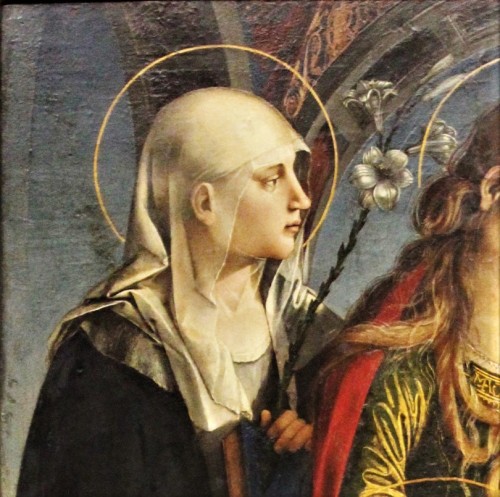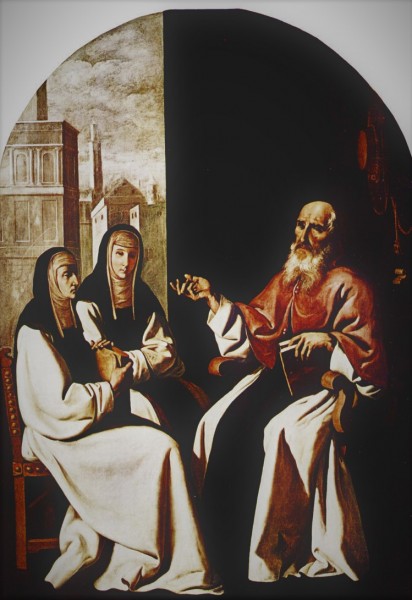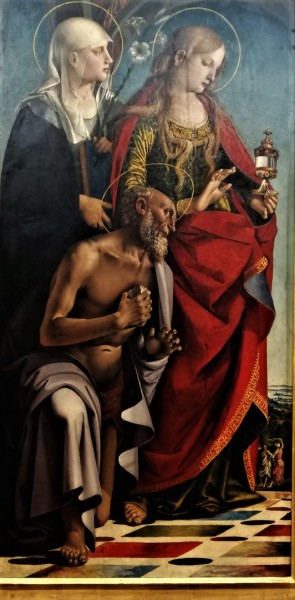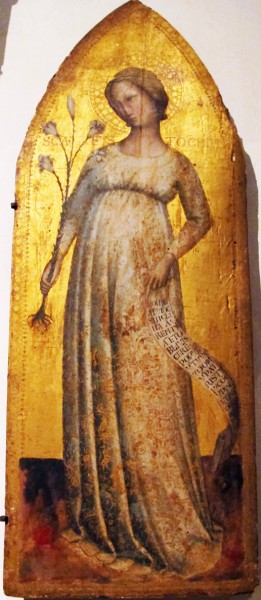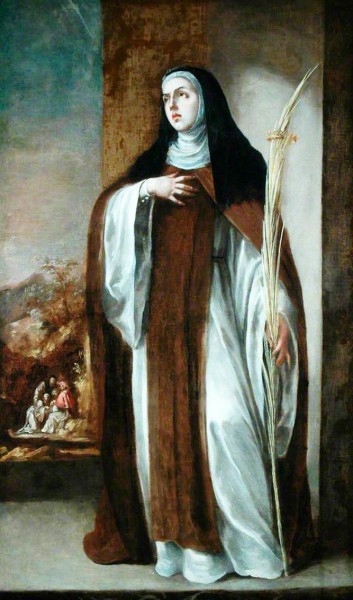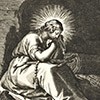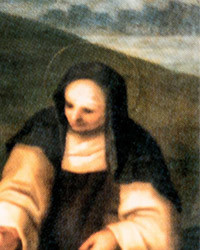Julia Eustochia, affectionately known as Eustochium, is remembered in history as a devoted student of Jerome – the creator of the Vulgate, an outstanding speaker, and a zealous ascetic. She was raised in an aristocratic Roman household with great traditions, among four siblings, in a time when Christianity was becoming more and more popular in the city on the Tiber, but the cult of pagan deities was still practiced. Her father, Toxotius, was a pagan, on the other hand, her mother Paula was a devout Christian. At the moment of her father’s death in 379, the girl was only eleven years old and she was faced with a grieving, still young, thirty-two-year-old mother-widow, who more and more fervently searched for a sense of life in faith. Paula found similar women at Marcella’s – another Roman aristocrat, who brought together a group of women who prayed and read the Bible, which at that time was mainly available in its Greek translation (the so-called Septuagint). When they were unsure of the Bible’s meaning they sought out the original Hebrew version. Eustochium accompanied her mother to these meetings, and her knowledge of Greek and progress in learning Hebrew were quickly noticed. When Jerome came to Rome, Eustochium was fourteen years old, so she was at the age when girls are generally married off. The newcomer from the East rapidly became a common guest at Marcella’s home, finding interlocutors worthy of his intellect, enthusiastic, willing to ask questions, and trying hard to understand the more often than not ambiguous phrases of the Holy Scriptures, which at that time were being translated by Jerome (New Testament). But Jerome brought with him something more – a deep conviction about the superiority of a life in virginity, celibacy, seclusion, and asceticism. It was with this conviction, that he probably told the women about his stay on the desert in Syria, and about the communes of ascetics which sprung up there, and about the simplicity of life which provides the possibility for a spiritual bond with Christ. With Paula and Eustochium he found a friendly atmosphere and the warmth of the home, and it was especially Paula who declared her desire to live in widowhood, living in asceticism, while Eustochium took vows of eternal chastity, based on rejecting marriage. For Jerome, who similarly to the desert eremites followed the practice of celibacy, even though it was not yet mandatory among the clergy, the young woman was a shining example of a virgin, the first (according to him) among Roman aristocrats. During a Church ceremony, the girl received a veil (a sign of consecration) from the hands of the bishop, and she put on a modest tunic. Her spiritual father, as Jerome viewed himself, wrote a letter about her pertaining to this event in the year 384 (Letter 22), or more appropriately an essay on virginity, which provides a great insight into the lives of then Christians and canonic virgins. Their lives were wrought with dangers and traps, and Jerome wanted his charge to be aware of them. The letter was a sort of religious and practical instruction, explaining how to be a true virgin, and to a large extent contributed to the spread of the ideal of a life in the convent in the West. And so, as a canonic virgin Eustochium was obliged to corporeal purity, which constituted one of the main subjects of the aforementioned letter. Jerome also writes about the temptations to which the beloved of the Lord (a virgin) is susceptible. About fallen, foolish girls, who did not keep their vows (married) or even worse became agapetes (alleged virgins who lived together with the clergy or fictitious ascetics), since they were unable to properly manage their lives and reject these desires and addictions. And so, to tame her sexuality, Eustochium should be wary of wine (“Wine and youth between them kindle the fire of sensual pleasure!”), warm baths and overeating. But that is not all. Jerome writes to her in an apodictic tone: “Do not court the company of married ladies or visit the houses of the high-born. Do not look too often on the life which you despised to become a virgin”. He even forbids her from visiting holy places and welcoming the clergy and ascetics, because even among them there are wolves in sheep’s clothing. On the other hand, he calls for the mortification of the flesh, reading the Scriptures, and prayer, even at night. And what in exchange? Here Jerome lets his oratory skills loose: “Ever let the privacy of your chamber guard you; ever let the Bridegroom sport with you within. Genesis 26:8 Do you pray? You speak to the Bridegroom. Do you read? He speaks to you. When sleep overtakes you He will come behind and put His hand through the hole of the door, and your heart shall be moved for Him; and you will awake and rise up and say: "I am sick of love." Then He will reply: "A garden inclosed is my sister, my spouse; a spring shut up, a fountain sealed. Let foolish virgins stray abroad, but for your part stay at home with the Bridegroom»”.

Let us remind ourselves, that the idea of life in consecrated virginity has its roots in the II and III centuries, but until this time instances of such life were rather scarce, and they were mostly used to create legends about saint virgins defending their chastity on par with their faith. In these legends, the purity of the heroines, which was at a constant threat from pagans was emphasized, along with a disregard for death, which resulted in suffering and martyrdom. In the second half of the IV century in some Christian circles of Roman women aristocrats regardless of the fact whether they were wives, widows, or virgins, sexual abstinence along with starvation, neglecting clothes and hygiene became very popular. In addition, these women avoided social parties, even to the point of completely shutting themselves off in their houses, and sometimes traveling to remote places. The highest position on this ladder of asceticism, according to Jerome, was occupied by virgins, based on the words of Saint Paul, who was the first to underline the superiority of celibacy especially of widows and virgins, in the face of the approaching Parousia (the Second Coming of Christ) - it was to be awaited in chastity and sexual restraint. As Paul claimed, those who live in restraint (bachelors, widows, virgins) are not filled with worries about everyday life and family, but they can fully devote themselves to the Lord. Centuries passed, yet the Parousia did not come to pass, while the elevation of the virginity of girls and young widows became more and more problematic condemning the Christians to die out. There was a general awareness of this fact, that is why, Jerome’s proposal – praising consecrated virginity and widowhood – was widely commented on in the city. An anecdote says that there was even a popular saying “Fathers hide your daughters because Jerome is coming”, fearing that some girls might want to join him. Pagans were hostile towards Jerome, while representatives of the Church were ambivalent in this matter, although some did notice the harm behind his teachings. Yet Jerome was unfazed, writing polemic epistles, in which he fought against the opponents of the superiority of virginity, even going as far as formulating an almost heretic statement: „Since according to Saint Paul (7, I Letter to the Corinthians) the only argument for marriage is avoiding debauchery, meaning a greater evil, then we cannot speak of marriage as of something good”.

In the meantime, there was a great change taking place in the life of Eustochium. After the tragic death of her oldest sister Blaesilla, who died due to an overly rigorous asceticism (starvation), her mother decided to leave Rome, along with the younger daughter and Jerome, accused of causing the older girl's death. Eustochium bid farewell to Rome and her siblings, and they all went to the Holy Land. After a several-month-long journey, which was a kind of a religious pilgrimage – from Antioch along the Syrian coast, to Palestine, then Jerusalem, Galilea, and Egypt – they settled near Bethlehem. Thanks to Paula's money they began the construction of two separate monasteries – for men and women which were to bring together monks and nuns vowing purity. Paula, who was very severe upon herself, led the women. Both she and her daughter also aided Jerome, who occupied himself with the translation of the Old Testament, most likely not only financially but also with their knowledge. And it would not be an exaggeration to say that Eustochium “who sang the Psalms in Hebrew and pronounced words without any Latin accents”, was an important aide of Jerome, which can be testified to by the fact that the comments to the Book of Ezekiel and Isiah were dedicated to her.
Jerome himself, however, put a greater emphasis on her other virtues, painting a portrait of an ideal daughter and Christian: "She always kept close to her mother's side, obeyed all her commands, never slept apart from her, never walked abroad or took a meal without her, never had a penny that she could call her own, rejoiced when her mother gave to the poor her little patrimony” (Letter 108). After Paula’s death in the year 404, the thirty-six-year-old Eustochium took over her tasks, helped by her niece Paula II, who arrived from Rome, after taking vows of chastity.
An unexpected attack in the year 417 by a group of supporters of the teaching of Pelagius, which Jerome criticized at every turn, led to the robbery, destruction, and burning of the monastery buildings, but also instances of rape on the nuns. Residents of the commune dispersed. Two brave women oversaw the reconstruction, while Jerome left. He came back weak and blind. In the year 419, Eustochium suddenly died, and soon after she was followed by Jerome.
Her cult, although she became a saint, was not popular. In Rome, there is not a single church dedicated to her. In art, her images are rare indeed, and if she is depicted it is generally with her mother, accompanied by Jerome. She was forgotten similarly to millions of nameless nuns, vowing to lead a life that was modest, bereft of any desires and fame in the name of an almost paraphysical unity with the Betrothed – Jesus Christ.
If you liked this article, you can help us continue to work by supporting the roma-nonpertutti portal concrete — by sharing newsletters and donating even small amounts. They will help us in our further work.
You can make one-time deposits to your account:
Barbara Kokoska BIGBPLPW 62 1160 2202 0000 0002 3744 2108
or support on a regular basis with Patonite.pl (lower left corner)
Know that we appreciate it very much and thank You !

